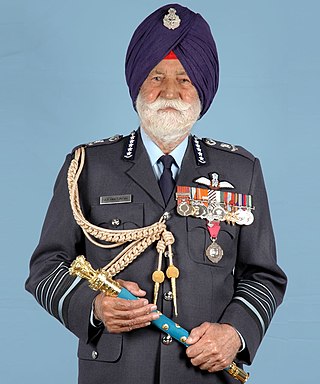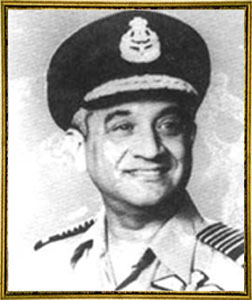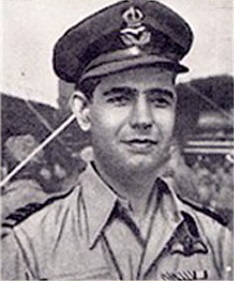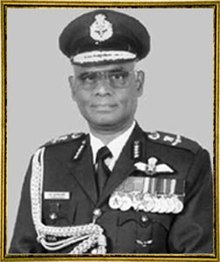
Marshal of the Indian Air Force Arjan Singh, was a senior air officer of the Indian Air Force. He served as the 3rd Chief of the Air Staff from 1964 to 1969, leading the Air Force through the Indo-Pakistani War of 1965. He was the first and only officer of the Indian Air Force (IAF) to be promoted to five-star rank as Marshal of the Indian Air Force, equal to the army rank of Field Marshal.

Air Chief Marshal Pratap Chandra Lal, DFC was the Chief of Air Staff (CAS) of the Indian Air Force (IAF) during the Indo-Pakistani War of 1971. He served in the IAF from 1939 until his retirement in 1973. He was the CAS at the time of Operation Chengiz Khan, the preemptive strikes that were carried out by the Pakistan Air Force (PAF) that marked the formal initiation of hostilities of the war.

The Vice Chief of the Air Staff (VCAS) is the deputy to the Chief of the Air Staff of India and second-highest ranking officer of the Indian Air Force. The VCAS is a PSO at Air Headquarters at New Delhi. In the event that the Chief of Air Staff (CAS) is absent or is unable to perform his duties, the VCAS assumes the duties and responsibilities of the CAS. The VCAS is normally held by an officer of three star rank and is held by an air officer of the rank of Air Marshal.

Idris Hasan Latif, PVSM was a former air officer in the Indian Air Force. He served as the 10th Chief of Air Staff (CAS) of the Indian Air Force (IAF) from 1978 to 1981. After retiring from the air force, he served as 11th Governor of Maharashtra from 1982 to 1985.

Subroto Mukerjee OBE was an Indian military officer who was the first Indian Commander-in-Chief (C-in-C) of the Indian Air Force. He was awarded several honours during the course of a three-decade-long career, ended by his untimely demise in 1960. He has been called the Father of the Indian Air Force.

The Chief of the Air Staff (CAS) is a statutory office held by the professional head of the Indian Air Force (IAF), the aerial branch of the Indian Armed Forces. Customarily held by a four-star air chief marshal, the CAS is the senior-most operational officer of the IAF, mandated with the responsibilities of supervising the force's overall functioning during states of peace and wartime, committing to the establishment-cum-continuity of air deterrence and executing India's security objectives vis-à-vis the preservation of the country's air sovereignty.

Air Marshal Aspy Merwan Engineer DFC was an officer in the Indian Air Force who rose through the ranks to become independent India's second Chief of the Air Staff, succeeding Subroto Mukerjee in 1960 and preceding Arjan Singh.
Air Chief Marshal Anil Yashwant Tipnis, PVSM, AVSM, VM, ADC served as Chief of the Air Staff of the Indian Air Force from 31 December 1998 to 31 December 2001. He commanded the Air Force to distinction during the Kargil War, when the force flew air superiority and close air support at heights of over 18,000 feet

Arup Raha, PVSM, AVSM, VM, ADC, is an Indian Air Force veteran and was the 21st Chief of the Air Staff of the Indian Air Force and served from 31 December 2013 to 31 December 2016. He was also the Chairman of the Chiefs of Staff Committee, a post occupied by India's senior-most military officer, who advises the government and ensures jointsmanship in the armed forces. Currently, he is the Chancellor of Assam University.

Air Marshal Ramaswamy Rajaram, DFC (1917–1969) was a senior officer in the Indian Air Force. He died in harness while serving as the Vice Chief of Air Staff (VCAS) of the Indian Air Force. He was the Air Officer Commanding-in-Chief Western Air Command during the Indo-Pakistani War of 1965.
Air Marshal Minoo Merwan Engineer, PVSM, MVC, DFC was a former Air Officer in the Indian Air Force. He is one of the most decorated officers in the Indian Air Force, with the third-highest civil decoration - the Padma Bhushan, two gallantry awards - the Maha Vir Chakra and the Distinguished Flying Cross, and the highest peace-time distinguished service award - the Param Vishisht Seva Medal.

Air Chief Marshal Hrushikesh Moolgavkar, PVSM, MVC was a former Air officer in the Indian Air Force. He served as the 9th Chief of the Air Staff of the Indian Air Force from 1 February 1976 to 31 August 1978.
Air Chief Marshal Satish Kumar Sareen, PVSM, AVSM, VM, ADC was the Chief of Air Staff of Indian Air Force from 31 December 1995 till 31 December 1998.

Air Chief Marshal Birender Singh Dhanoa, PVSM, AVSM, YSM, VM, ADC is an Indian air force officer who was the 22nd Chief of the Air Staff of the Indian Air Force and served from 31 December 2016 to 30 September 2019. Dhanoa also served as the Chairman of the Chiefs of Staff Committee.

Air Marshal Chandrashekharan Hari Kumar, PVSM, AVSM, VM, VSM, ADC is a retired officer of the Indian Air Force. He served as Air Officer Commanding-in-Chief (AOC-in-C), Western Air Command from 1 January 2017 to 28 February 2019. He assumed the office from Air Marshal Shirish Baban Deo and was succeeded by Air Marshal Raghunath Nambiar.

Air Marshal Anil Khosla, PVSM, AVSM, VM, ADC is a retired Indian air force officer who served as 42nd Vice Chief of the Air Staff (VCAS) of the Indian Air Force. He assumed the office on 1 October 2018 and handed over on 30 April 2019.

Air Marshal Ravinder Kumar Dhir PVSM, AVSM, VM, ADC is an advisor to Gujarat state for 'Defence and Aerospace Industries'. He was Air Officer Commanding-in-Chief (AOC-in-C), South Western Air Command of the Indian Air Force from 1 June 2015 to 29 September 2018. He took over from Air Marshal Birender Singh Dhanoa and was succeeded by Air Marshal Harjit Singh Arora.

Air Marshal Raghunath Nambiar, PVSM, AVSM, VM & Bar is a retired officer of the Indian Air Force. He served as Air Officer Commanding-in-Chief (AOC-in-C), Western Air Command from 1 March 2019 to 31 October 2019.
Air Vice Marshal Erlic Wilmot Pinto, PVSM was an Air officer in the Indian Air Force. He was the Air Officer Commanding-in-Chief (AOC-in-C) Western Air Command when he was killed in the 1963 Poonch Indian Air Force helicopter crash. He served in the IAF from 1940 until his death in 1963. He was the theatre air commander commanding the air operations during the Annexation of Goa.

Air Vice Marshal Harjinder Singh, PVSM, MBE was an Air Officer in the Indian Air Force. He was one of the earliest to join the newly created Indian Air Force (IAF) in 1933 in the lowest rank of 'Hawai sepoy'. In a career spanning over three decades and two wars, he rose from the lowest enlisted rank to the then second-highest rank in the Indian Air Force. Hailed as technical wizard and innovator, he is considered a legend of the IAF.


















